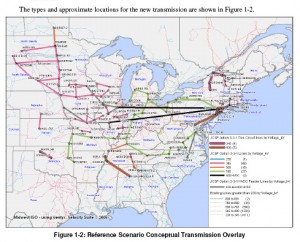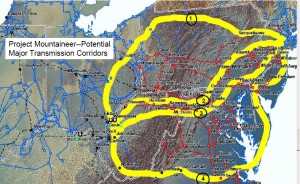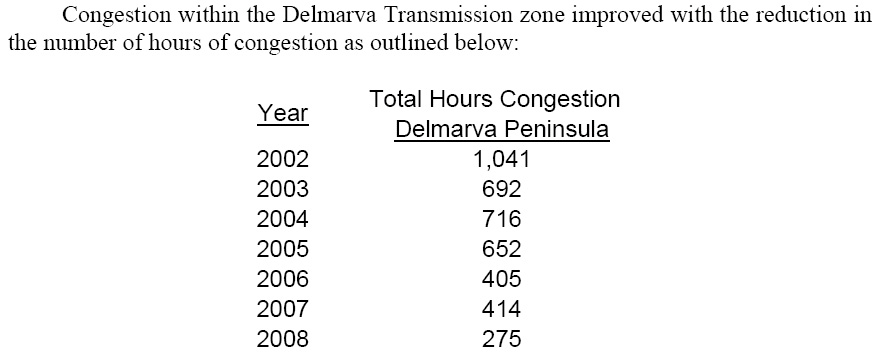ALJ: Underground Hiawatha Project
October 9th, 2010
Underground Xcel’s Hiawatha Project transmission. That’s BIG, it’s good news, except for one thing — “Who pays?” is still a question:
ALJ Heydinger’s Recommendation for Xcel’s Hiawatha Transmission Project
Problem is, cost allocation isn’t dealt with specifically, only explained, so no recommendation regarding that.
If the PUC went ahead, would it be spread across the Metro area, the full Xcel rate base, or???
For the SE Metro, and for the Chisago Transmission Project, if they cities would have agreed to shoulder the cost, undergrounding was no problem. But that’s not feasible for a city to pay. So now what? Will the PUC actually order undergrounding, with a broad rate base recovery?
Susquehanna-Roseland reopened!
January 27th, 2010
The Susquehanna-Roseland hearing has been reopened. And off we got to FERC. It’s been quite a hectic week, with a “flurry” of filings, and here’s the update. First, remember the NJ BPUat a special 1/15 meeting said they were NOT going to decide on PSE&G’s Susquehanna-Roseland transmission line and said they’d be asking for more information from PJM. Well, they asked PJM to answer a few questions (though not specific enough, not the right questions):
Here’s what PJM had to say:
Suffice it to say, the letter is … ahem… INSUFFICIENT!
And then the responses started coming in, first the Municipal Intervenors, then :
Municipal Intervenors response to PJM Letter
And the BPU issued an Order reopening the docket and first scheduled a hearing for February 2, 2010, and then THANKFULLY changed it to February 4, 2010:
The concept is that PJM is coming in as a witness regarding the assertions of their January 21, 2010 bullshit letter, and what does that mean? Is Steve Herling THE witness, or are there others? Is whatever witness/es coming with a truckload of exhibits that they’ll dump on us the day of the hearing? Is he going to be prepared in any way to back up his conclusory and unsupported statements? So I fired off a couple missives, first Discovery to get the requests in quick and let them be on the record of ignoring or refusing to answer, and then a letter to the BPU with my view of the fine mess we’re in:
As a sidebar, the escrow that PSE&G had to put out for the Municipal Intervenors is gone, this has been an intense case, and so they’re reasonably asking for more:
Meanwhile, back at the ranch, remember that great 7th Circuit decision tossing out the cost allocation for this project? Everything’s been up in the air since then, because if they can’t settle how they’re going to allocate the costs, this sucker won’t be built:
It was remanded to FERC and after some wrangling, just like in the BPU case, where the utilities were saying, “It’s all there in the record, you don’t need anything more to make a separate decision” and Illinois said quite succinctly, “AHEM, WE DON”T THINK SO!” and FERC issued an Order stating that the record was not sufficient, needed more information and directed PJM to provide some information and also provided some questions for parties to mull over in their comments:
Here’s the fun part – what they asked PJM to provide (hee hee hee hee hee hee), starting on p. 5 of the above Order:
10. PJM should provide the following information:
A. The total costs that have been approved through PJM’s Regional Transmission Expansion Plan (RTEP) process for facilities that operate at or above 500 kV (and necessary lower voltage facilities), and whose costs are assigned pursuant to Opinion No. 494. For these projects, calculate the total costs that have been assigned to each PJM zone, and estimate the total costs that would be assigned to each zone using PJM’s DFAX methodology.
B. PJM manuals require that, in planning projects, it seek to optimize projects in order to reduce the cost of addressing individual reliability criteria. Describe how the optimization process is performed. Also, explain how PJM determines the relative priorities of resolving numerous reliability issues with one project. For 500 kV and above facilities, explain whether PJM could accurately determine the beneficiaries of a project that resolves numerous reliability issues using its DFAX methodology.
C. PJM’s most recent RTEP report (2008), at P 5 states that:
Baseline thermal and voltage analysis encompasses an exhaustive analysis of all Bulk Electric System (BES) facilities for compliance with NERC Category A (TPL-001), Category B (TPL-002) and Category C (TPL-003) events. In addition, consistent with NERC standards TPL-004, a number of extreme events including those judged to be critical from an operational perspective as well as those defined in Table I of TPL-004 were evaluated for risk and consequence to the system. Describe the types of anticipated reliability requirements addressed by the PJM RTEP (i.e., voltage, thermal, stability). Explain whether and how the DFAX analysis applies to the NERC reliability analyses listed above and any other reliability requirements. Explain whether the RTEP upgrades designed to address these reliability requirements also will address other reliability concerns. In particular, explain whether the geographic location or voltage level of an RTEP upgrade makes that upgrade more likely to address broader reliability concerns.
Provide any relevant studies.D. In this proceeding, PJM recommended the adoption of a postage-stamp rate design for new 500 kV and above facilities.
1. Describe the benefits generated by such facilities that are not captured in the DFAX methodology used by PJM to allocate costs for lower voltage facilities. Indicate whether such lines provide reliability or economic benefits to the areas producing electricity.
2. Provide engineering or other studies showing any differences in regional benefits between 500 kV and lower voltage facilities (e.g., 345 kV
and 230 kV).E. Provide any existing engineering or other studies that indicate whether the modeling assumptions used in the RTEP analysis, such as the direction of flow,
remain consistent or vary over time.
The Municipal Intervenors sent in a Motion to FERC, PSEG objected, and then Stop the Lines sent in a Motion for Limited Intervention:
Municipal Intervenors – Motion to Intervene
PSEG Response to Munis FERC Intervention
Stop The Lines! Motion for Limited Intervention
PSEG’s response to our Motion to Intervene… yeah… (yawn)… what-ev-er…
And just now, hot off the press, the Municipal Intervenors have filed a Motion to Depose PJM’s Steven Herling! Oh, yes, this is much needed, so we can get an idea where they’re going and what they plan to present (I doubt they’d produce the pre-filed testimony I requested!):
As you can see, it’s been an intense few days, and isn’t letting off anytime soon. More to follow as it develops.
Offshore transmission, NOT transmission from Midwest
December 6th, 2009
By standing up for offshore transmission for wind, Delaware’s Gov. Jack Markell stands up to Midwest coal!
The Mid-Atlantic states have been standing up and opposing transmission from the Midwest. They’ve gone on record in a number of venues, and in their opposition are citing Midwest transmission promoters’ disregard for eastern renewable efforts, that xmsn may well not be an economical way to get power to the east, and that THEY KNOW THAT MIDWEST TRANSMISSION PLANS INHERENTLY ARE ABOUT COAL. The plan they’re referring to is a massive transmission buildout known as JCSP, and it also applies to the big PJM buildout that includes the PA-NJ Susquehanna-Roseland transmission line that was the subject of a hearing last month.
Here’s JCSP (Joint Coordinated System Plan) note their site now talks about wind — but look where the transmission starts, DUH! The coal fields of the Dakotas:
Gotta give them, Delaware, Maryland and Virginia, a lot of credit for recognizing and stating what Midwest states have been unwilling to admit.
That said, here’s what Mid-Atlantic states are doing — they’re banding together to propose offshore transmission. If it’s underwater offshore transmission, that’s an idea that’s hard not to like. But I’ll bet it throws PJM for a loop, what with all their “backbone” transmission schemes, a la Project Mountaineer, that are in the works:
The FERC birth of Project Mountaineer:
And you can see that those lines in play now, PJM’s “backbone” transmission projects like Susquehanna-Roseland (NE part of Project Mountaineer Line 1) and MAPP (NE part of Project Mountaineer Line 4) are part of the plan… the big transmission plan that does not work for the east coast.
Here’s the Memorandum of Understanding between Delaware, Maryland and Virginia:
And recently, Gov. Jack Markell addressed these issues before American Wind Energy Association’s offshore windfest — but given the PJM big-transmission-projects-from-hell are referred to as “backbone” projects, I wish they’d find another term:
Delaware energy: ‘Backbone’ power line pushed for wind farms
By AARON NATHANS
The News JournalGov. Jack Markell broached the subject this week in his address to the American Wind Energy Association’s offshore wind workshop, the industry event of the year on this side of the Atlantic. Markell signed onto letters the governors sent to members of Congress this summer, and the Federal Energy Regulatory Commission last month.
“Let’s have the conversation,” O’Mara said. “It’s extremely worthy of further study.”
“It obviously won’t happen in the absence of federal leadership,” he said.
Fishermen’s Energy President Daniel Cohen said it’s a good idea, but “it’s another moving part.”
The benefits of building lines transmitting wind power from the Midwest are less certain, he said.
“It will be difficult to get progress in this area until there are clear national goals,” he said.
Note that “cost allocation” is raised. Since the 7th Circuit decision tossing out FERC approval of PJM’s transmission cost allocation dream/nightmare, all transmission projects 500kV and over based on that cost allocation scheme are in limbo.
So as noted, who pays, and submarine transmission is EXPENSIVE, is THE big issue now. It’s the big issue for land transmission, it’s the big issue for offshore transmission, and, given the uncertainty since the 7th Circuit decision, maybe some of the sturm and drang could be circumvented if it’s designed at 345kV or below, and uses the “benefactor pays” theory. We shall see…
UMTDI – “Survey” looking for …
August 28th, 2009
I think it’s one of those things where they’re working toward a pre-ordained result.
Here’s the “Survey” and “Legal Analysis: that arrived a couple weeks ago:
“Legal Analysis” my ass… how lame… do they think we’re that stupid?
Note the date, it’s the same date that this great 7th Circuit decision came out on cost allocation:
And then there’s all that cost allocation “problem” with Otter Tail Power and WOW/AWEA:
AWEA and WOW’s FERC filing to protest MISO cost allocation proposal
Methinks they doth protest too much… again… what they’re doing is so transparent, conflating collection, transmission, delivery, looking for a way to justify treatment as the same…
I DON’T THINK SO!
7th Circuit tosses out FERC & PJM cost apportionment
August 13th, 2009
I was a big Posner fan in law school, mostly because he was so much fun to pick on, I so hate the “Chicago school.” But here’s another Posner, doing good! It’s a hilarious opinion, all the better because it so clearly tells FERC and PJM what to do with their rate shifting cost apportionment. GO POSNER!
Here’s the decision:
Two issues in this case:
1) PJM/FERC pricing based on marginal cost v. pricing including sunk costs. That one went for PJM/FERC, and American Electric and others lost in just a few paragraphs.
2) Where the action is — Ohio and Illinois Commissions objected to the 500+kV cost allocation on a pro rata basis, that “their rats should be raised by a uniform amount sufficient to defray the facilities’ costs.”
What’s particularly interesting to me is that this is all about “Project Mountaineer,” which PJM doesn’t even want to acknowledge exists! the Susquehanna-Roseland line that I’m working against is the NE part of line 1, and the MAPP line through now “just” a part of Delaware is the NE part of the southern line, line 4. Here’s the magnitude of Project Mountaineer – the Susquehanna-Roseland line is QUAD 500kV plus double circuiting the existing 230kV line, that’s one big project:
FYI, in the Cudahy dissent, he did some digging, and there is a Project Mountaineer tootnote quoting PJM stating that Project Mountaineer “would bring about substantial congestion relief and reliability improvements increasing Midwest-to-east transfers by 5,000 MW.” See Ventyx, Major Transmission Constraints in PJM (2007).
A quick sidebar… FYI, from Delaware Electric Cooperative 2009 Energy Plan – “CONFIDENTIAL”, arguing for the MAPP transmission project…
… and they report that transmission congestion is down 75% to 275 hours ANNUALLY! Really… so for that 275 hours we should build the $1.2 MAPP project? HOW STUPID DO YOU THINK WE ARE?
OK, back to Posners 7th Circuit decision. It was PJM’s idea, approved by FERC, to hit up all the utilities, and Illinois, a BIG example of the problem, would have had to pay out some $480 million while not receiving one dime of benefit. PJM used the theory that, well, PJM used to do it this way all the time before in massive infrastructure buildouts, but as Posner reminded them, that was then and this is now, PJM is a lot different now, Illinois wasn’t even part of the picture.
Posner was pissed off that there was no data at all to support their desired allocation, no data, no specifics about difficulties in assessing benefits, no lawsuits about inequities, no particulars, “[n]ot even the roughest estimate of likely benefits to the objecting utilities… oh yes, he let them have it… for page after page… and notes that FERC “brief devotes only five pages to the 500kV pricing issue.” FERC seems to presume a similar brainwashing in the courts that they and utilities presume of Commissions and legislatures, one that I see to often, that frantic claim of URGENT need, ‘WE’RE GOING TO FREEZE IN THE DARK IN AN INCUBATOR WITHOUT A JOB” theory, presented despite documented long term decrease in demand across the country. Once more with feeling, HOW STUPID DO YOU THINK WE ARE?
Oh, these guys irritate me. Anyway, check out this decision and consider the impact on all the 500kV and above projects applied for or waiting in the wings.












